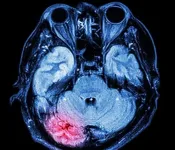(Press-News.org) C3 glomerulopathy (C3G) is a very rare immunological (or more precisely: complement-mediated) inflammation of the glomeruli. Due to progressive renal dysfunction, many such patients have to go on dialysis or receive a kidney transplant after about ten years. C3G has to date been treated by lowering blood pressure and proteinuria and by non-specific immunosuppression. In order to compare different therapeutic approaches in the future, a 'European Register for C3 glomerulopathy and immune-complex-mediated MPGN', in which cases are systematically registered, was initiated in 2015.
Pathogenetic dysregulation in the 'alternative complement signaling pathway' of the immune system leads to glomerular deposits of complement factor C3 (a protein). Permanent overactivation of the signaling cascade also causes elevated levels of the C5 and C5a factors. C5a is a potent inflammatory mediator that acts via the associated C5a receptor. In preclinical studies, C3G progression was markedly slowed with the selective C5a receptor inhibitor avacopan.
The ACCOLADE study conducted a randomized, double-blind placebo-controlled investigation into the use of avacopan in C3G patients. For 26 weeks, they received either 30 mg of orally administered avacopan twice daily (n=28), or placebo (n=29). The C3G Histologic Index (C3HI 'Disease Activity Score') was used to measure changes in histology over time by means of repeat kidney biopsies (higher values indicating severe disease). Secondary endpoints were the histologic disease chronicity score (degree of fibrosis), the glomerular filtration rate (eGFR), and proteinuria (UPCR - urinary protein to creatinine ratio).
The patients had been diagnosed with C3G 46-48 months on average before enrollment; in the avacopan group, the mean eGFR was 76.27 ml/min/1.73 m2; proteinuria (> 1 g/g) was present in 76.9% of patients. In the placebo group, eGFR was 73.42 ml/min/1.73 m2, while 69.2% had proteinuria (> 1 g/g).
At 26 weeks, the C3HI activity score improved by 0.2% in the avacopan group, but worsened by 20.6% in the placebo group. The C3HI chronicity score increased by 31.7% in the avacopan group and by 57.5% in the placebo, which equates to an absolute change of 0.8 versus 1.6, respectively. The eGFR changes were also statistically significant; in the avacopan group, eGFR increased by 4.8% on average and decreased in the placebo group by 5.9% (p=0.02). Patients with a previous eGFR less than 60 ml/min/1.73 m2 benefited particularly from the therapy, as their eGFR increased by 13% (compared to a 6.1% decrease for placebo). Proteinuria also improved in the avacopan group. The tolerability and safety profile of avacopan did not differ on the whole from placebo.
'In patients with C3 glomerulopathy, targeted therapy aimed at the complement system provides the best possible route to slow disease progression,' explains Dr Bomback. 'In addition, the more selectively we target the causal disease mechanisms in the immune system, as was done in this study at the C5a receptor with avacopan, the less the immune system as a whole is suppressed, which should also yield not only more effective but also less toxic therapies.'
'Targeted immunomodulation is already used to treat various diseases and will play an increasingly important role in the future if we want to treat C3G effectively yet safely.'
INFORMATION:
[1] 2478 Andrew Bomback, New York. Orally administered C5aR Inhibitor Avacopan in a randomized, double blind, Placebo-controlled Study (ACCOLADE) for Treatment of C3 Glomerulopathy
About ERA-EDTA
With more than 7,000 active members, the ERA-EDTA is one of the biggest nephrology associations worldwide leading European nephrology and one of the most important European Medical Associations. It organizes annual congresses and other educational and scientific activities. ERA-EDTA also collects data, and performs epidemiological studies through its Registry. The Society supports fellowships and educational/research projects through its committees and working groups. Its publications are NDT, CKJ (Open Access journal), and the online educational portal NEP.
The 59th Congress will take place in May 19-22, 2022, both virtual and live in Paris (France).
Website: http://www.era-edta.org
Researchers at the University of Adelaide have used more than two decades of satellite-derived environmental data to form hypotheses about the possible foraging habitats of pre-contact Aboriginal peoples living in Australia's Western Desert.
As one of the most arid and geographically remote regions of Australia, the Western Desert has always presented severe challenges for human survival. Yet despite the harsh conditions, Aboriginal peoples have maintained an enduring presence, continuously adapting to environmental variations through complex socioeconomic strategies.
In the study published in Scientific Reports, the researchers used Earth Observation data to ...
Focal segmental glomerulosclerosis (FSGS) is a rare form of kidney inflammation (glomerulonephritis) in which the glomeruli become increasingly scarred (sclerotic), leading to progressive loss of kidney function. Dysregulation of the immune system plays a role in pathogenesis, which is why immunosuppressive therapy with glucocorticoids can be successful, alongside supportive therapy (especially blocking of the renin-angiotensin system with ACE inhibitors or angiotensin receptor blockers). Many patients nevertheless require dialysis in the course of the disease. New therapeutic approaches that stabilize or protect kidney function ...
Accumulation of water in the lungs (lungcongestion) is a common condition in hemodialysis patients, particularly in those at high cardiovascular risk, like those presenting coronary artery disease and/or heart failure. This alteration can be detected in an X-ray image, but cannot be heard easily with a stethoscope. When the congestion becomes so severe that fluid floods the alveoli ('alveolar pulmonary edema'), the sound of rattling breathing can be heard (and without a stethoscope at a later stage). Then, at the latest, pulmonary gas exchange is severely impaired, and the patients experience shortness of breath or even fear of death.
For hemodialysis patients, ...
The battle against antibiotic-resistant bacteria: A new study at Tel Aviv University revealed a mechanism through which "good" viruses can attack the systems of "bad" bacteria, destroy them and block their reproduction. The researchers demonstrated that the "good" virus (bacteriophage) is able to block the replication mechanism of the bacteria's DNA without damaging its own, and note that the ability to distinguish between oneself and others is crucial in nature. They explain that their discovery reveals one more fascinating aspect of the mutual relations between bacteria and bacteriophages and may ...
IgA nephropathy (IgAN) is a chronic kidney disease occurring in young adults and is one of the most common reasons for kidney transplantation in this age group. IgAN is the most common form of glomerulonephritis (GN), i.e., immunologically induced inflammation of the renal glomeruli. It is characterized by glomerular deposition of immune complexes containing immunoglobulin A (IgA), and by a complex inflammatory response and progressive loss of kidney function. For many decades, IgAN has therefore been treated with anti-inflammatory or strong immunosuppressive agents. ...
Wider clean chemistry applications of the extraordinary Vortex Fluidic Device - invented by Flinders University's Professor Colin Raston - are likely in the wake of new research that has been published outlining the seemingly endless possible uses.
The defining paper on understanding fluid flow in the Vortex Fluidic Device has just been comprehensively explained in an article published in Nanoscale Advances (DOI: 10.1039/D1NA00195G).
This took more than 100,000 experiments to work out - and Professor Raston hopes this publication will encourage more researchers to embrace the VFD and explore yet more innovative applications for this ingenious device.
"How fluid flows is one of the grand challenges of science," says Professor Raston. "What we have been ...
A world-first international study led by the University of South Australia has identified a new drug to stop athletes developing dementia after sustaining repeated head injuries in their career.
The link between concussion and neurogenerative diseases is well established, but new research findings could halt the progression of chronic traumatic encephalopathy (CTE) in sportspeople who sustain repeated blows to the head.
CTE is a progressive and fatal brain disease associated with the accumulation of a protein known as hyperphosphorylated tau which affects cognition and behaviour.
In a paper published in Scientific Reports, ...
LA JOLLA, CALIF. - June 7, 2021 - A preclinical study led by scientists at Sanford Burnham Prebys has established that AAV8-TNAP-D10--a gene therapy that replaces a key enzyme found in bone--may be a safe and effective single-dose treatment for hypophosphatasia (HPP). The study, published in the Journal of Bone and Mineral Research and performed in a murine model of the disease, further supports advancing the therapy toward human clinical trials.
"This is the most promising gene therapy study to date demonstrating a successful increase in life span, and improvement ...
Monash University researchers have provided a fundamental advance regarding how T cells become activated when encountering pathogens such as viruses.
The recent study published in Science, co-led by Professor Nicole La Gruta, Professor Jamie Rossjohn and Professor Stephanie Gras with first author Dr Pirooz Zareie from the Monash Biomedicine Discovery Institute, have found that T Cells need to recognise pathogens in a particular orientation in order to receive a strong activating signal.
T cells play a key role in the immune system by eliminating invading pathogens, such as viruses, and it is crucial to understand ...
When we inhale isolated coronavirus particles, more than 65% reach the deepest region of our lungs where damage to cells can lead to low blood oxygen levels, new research has discovered, and more of these aerosols reach the right lung than the left.
Lead author of the study Dr Saidul Islam, from the University of Technology Sydney, said while previous research has revealed how virus aerosols travel through the upper airways including the nose, mouth and throat - this study was the first to examine how they flow through the lower lungs.
"Our ...





